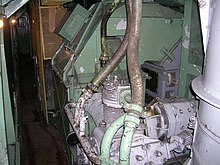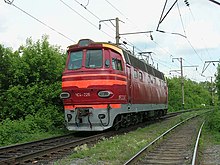SŽD series ЧС4
| SŽD series ЧС4 ČSD S 699.1001 ČD series 260 Škoda type 52E0 |
|
|---|---|
|
ЧС4 012
|
|
| Numbering: | SŽD ЧС4 001–160, 162–231 ČSD S 699.1001 ČD 260.001 |
| Number: | 230 |
| Manufacturer: | Škoda Plzeň |
| Year of construction (s): | 1963-1972 |
| Axis formula : | Co'Co ' |
| Gauge : | 1,520 mm 1435 mm |
| Length over buffers: | 20,000 mm |
| Length: | 18,760 mm |
| Height: | 4650 mm (with pantographs removed) |
| Width: | 3200 mm |
| Trunnion Distance: | 10,500 mm |
| Bogie axle base: | 4600 mm |
| Smallest bef. Radius: | 120 m |
| Service mass: | before reconstruction: 131.4 t after reconstruction: 126 t |
| Friction mass: | before reconstruction: 131.4 t after reconstruction: 126 t |
| Wheel set mass : | 21 t |
| Top speed: | 160 km / h |
| Continuous output : | 4800 kW |
| Starting tractive effort: | 320 kN |
| Driving wheel diameter: | 1250 mm |
| Power system : | 25 kV 50 Hz ~ |
| Power transmission: | Diode control |
| Number of traction motors: | 6th |
| Drive: | Škoda hollow shaft drive |
| Brake: |
DAKO - compressed air brake, electrical resistance brake |
| Locomotive brake: | DAKO compressed air brake |
| Train control : | LS III |
| Particularities: | Series production according to the ČSD S 699.001 locomotive with a locomotive body made of glass fiber reinforced plastic |
The SŽD class ЧС4 (German transcription TschS4) of the Soviet Railways (SŽD) emerged from the ČSD S 699.001 and was the series locomotive of this conception for the SŽD. The locomotive was manufactured by Škoda in Plzeň in 1963 and is equipped with a locomotive body made of fiberglass-reinforced plastic . In operational service, the locomotives are nicknamed Laminatka , Aquarium or Soap Dish .
history

Like its prototype, the locomotive has a locomotive body made of fiberglass-reinforced plastic. This direction of development was contested at the time in order to replace the material for the metal locomotive body with a maintenance-free, non-color-treatable one, in which only a basic color was applied. This resulted in a completely new design for the locomotive, for which the designers Miloš Franče and Otakar Diblík were mainly responsible. The goal was not fully achieved; in addition, laminate resins and additional color pigments with foreign exchange had to be imported by the capitalist states.
In 1962, following an order from the national economy of the then USSR, the Škoda locomotive factory in Plzeň began planning the first test locomotive ЧС4 001 , which was built until the end of 1963. The locomotive was made for the clearance gauge of the SŽD with the dimensions 3400 mm × 5330 mm. Of course, the locomotive was also intended for use with the SA3 central buffer coupling . For test drives on ČSD tracks , it was also possible to retrofit wheel sets in standard gauge as well as screw couplings.
technical description
Compared to the designs of the locomotives manufactured in the former USSR, the ЧС4 had great differences in design, both internally and externally. Compared to the prototype, the ЧС4 differed externally in the shape of the body; the position and tail lights are more prominent on the ЧС4, the headlight lamp also has a different shape. The front glazing consists of several segments. There is also triple side glazing in the driver's cab, where it can also be opened. With the SŽD it was customary to position the main air tanks on the roof, and this is how these locomotives got this special design feature. Originally the locomotive had ten small oval windows in the side walls. From the series locomotives onwards, six larger windows were used instead. The locomotives originally had the large rail clearer like the prototype had. When later on the experimental ring Velim used ЧС4.001 this was removed and replaced by two simple with simple plates and stiffening. In the rear driver's cab there is the option of entering the roof of the locomotive via a ladder through a security door. While the ventilation grilles under the roof of the first machine were arranged at an angle, they were designed with stiffening brackets on the series locomotives. The color scheme of the locomotives also looked very elegant, as can be seen very well in the museum ЧС4.012 . Originally the frame was gray, the lower part of the locomotive body dark red, the upper part of the body vermilion and the roof silver. The yellow stripes on the front wall of the design were also very decorative. In the course of their use, the color was changed several times. Like the ČSD S 699.001, the new machine attracted a lot of public attention and was a very elegant locomotive.
The mechanical and electrical equipment essentially consists of the elements of the S 699.0, with the exception of the electric traction motors and the renewed bogies. The electric brake is a special feature . Their load was 4 t and was one of the reasons that the test locomotive later had considerable overload problems with 131 t. Since it also proved to be ineffective, it was omitted from the series locomotives except for the tenth series. During the test operation, the maximum speed of the test locomotive was limited to 100 km / h due to the overload.
Trial operation
In 1964 the first locomotive, the ЧС4.001, was initially subjected to operational trials on the Plzeň - Horažďovice route with Škoda designers. The Velim experimental ring was not electrified at the time, so this variant could not be used at the time. After graduation, it was given to the former USSR in 1965 for operational trials. These tests were associated with some difficulties, which led to the locomotive having to be returned to the country of manufacture as a guarantee in 1966. Although the locomotive reached a speed of 145 km / h in the section Ха́нская - Майко́п , its drive in mountainous regions proved to be unable to cope with the tough demands. During the train operation with heavy loads, four couplings of the drive broke and smashed the drive wheels. The locomotive showed that it was not prepared for operation with the SŽD, some components did not correspond to its output of 4800 kW.
After returning from the USSR, the ЧС4.001 was initially converted according to the findings of the test operation. The machine was then not returned to the USSR, but after the reconstruction, the Velim experimental ring received the machine with a track width of 1435 mm and a screw coupling. The maximum speed of the locomotive was set at 160 km / h. The locomotive was given the designation S 699.1001 , from 1988 260 601-0 , and was retired here in 1990. In 1991 the locomotive was scrapped in Beroun .
In the course of 1965, based on the findings with the two prototypes S 699.001 and ЧС4.001, the design was initially completed, especially in the area of the bogies. Initially ten pilot series locomotives were manufactured at Škoda ( ЧС4.002 - ЧС4.011 ), which were given the Кавка́зская locomotive depot for testing . Various tests were carried out on the locomotives at
- ЧС4.002 1966 standing tests ,
- ЧС4.003 force and energy tests ,
- ЧС4.004 running tests and behavior of the locomotive on the track.
These tests were successful and provided the basis for large-scale production of the locomotives with a few modifications.
Use of the locomotives
A total of 230 vehicles of the series were produced by Škoda from 1965 to 1972. They were numbered 001–160 and 162–231 . Originally, the vehicles were intended for operation in the Kawkasskaya and Brjansk 2 depots . Later, the Kiew P, Kirow , Balaschow and Rossosh depots received the locomotives, and after the electrification of the Saratov - Rtishchevo section, the Saratov depot also received them. Their area of operation was the heavy express train service. After 1970 the successor version folgeС4т appeared in 230 copies. Its main features are the new tin locomotive body and the newer electric brake.
During their operational use, modernizations were carried out, which essentially related to the introduction of an automatic speed control . Major capital improvements have been made at the Zaporizhia plant in southern Ukraine . In the year 1999-2013 a general overhaul was carried out at this plant with an extension of the deadline for 105 locomotives. The machines received a new locomotive body similar to that of the ЧС7, with the body made of glass fiber reinforced plastic being exchanged for one made of metal, worn assemblies were exchanged, the wheels and the bogies were replaced. Essentially, these are locomotives from Ukraine with the numbers 017, 018, 019, 026, 036, 037, 039, 040-044, 046-050, 052, 054, 055, 058-061, 063-065, 067 , 069, 075–078, 080, 082–086, 088, 091, 094–097, 099, 100, 102, 105–111, 113, 117, 119, 122, 125, 128, 130˜ – 132, 136, 138, 141-142, 144, 146, 149, 153, 154, 156, 158, 159, 169, 173, 174, 178, 179, 183, 185-193, 195-201, 204, 205, 207-211. The basis for the exchange of the locomotive bodies was the complaint from the SŽD train drivers that the view of the open route was only controlled from 50 m to 70 m. The reasons for this were the distance between the driver's seat and the control panel and the height of the control panel.
Currently (2014) the locomotives are only operated in the KievP depot. In the Kirov and Balaschow depots they were replaced by the ЧС4т, in Saratov by the ЭП1 . To date, the locomotives have only been taken out of service after accidents and serious damage. At the moment that's 16 machines.
Locomotives in museums and on monuments
In 2004 four locomotives were handed over to museums of rail transport from the Saratov depot :
- ЧС4.012 in Saint Petersburg ,
- ЧС4.025 in Moscow ,
- ЧС4.029 in Rostov-on-Don and the
- ЧС4.023 in Novosibirsk .
In 2012, the ЧС4.072 was transferred from the KievP depot to the museum of the local train station. The ЧС4.226 has also been preserved.
See also
Individual evidence
Web links
- Website for the S 699.1 series on prototypy.cz (Czech)
- Photo of the prototype of the ЧС4 on the digital railway photo archive
- the particularly well-maintained ЧС4.083 in the Sherchenka train station , photographed on Bahnbilder.de










